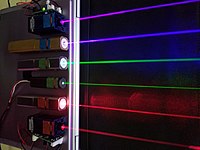
Photo from wikipedia
Abstract In laser welding, the spatial beam intensity profile of the laser beam is an important parameter as it has a considerable effect on the temperature distribution and cooling rate… Click to show full abstract
Abstract In laser welding, the spatial beam intensity profile of the laser beam is an important parameter as it has a considerable effect on the temperature distribution and cooling rate of the melt pool, which determine the weld properties. In this study, a laser beam with a spatially modulated intensity profile by a diffractive optical element (DOE) was applied to the laser beam oscillation welding of an aluminum alloy (AA5052), and the weld characteristics of modulated beam welding (MBW) were analyzed in relation to those of Gaussian beam welding (GBW). According to the result of experiment verifying full penetration condition, the MBW generally required a slower maximum beam speed for full penetration than the GBW due to laser energy spreading by the core and ring beam constitution. On the other hand, this dispersed laser energy of the modulated beam was more effective in formation of a stable melt pool, which in turn reduced weld defects (bumpy bead surface, pores, and cracks) compared with the GBW. It also played a role in improving the asymmetric morphology of the weld by generating a relatively even temperature distribution of the melt pool. From an electron back scatter diffraction (EBSD) analysis, it was found that columnar grains were mostly distributed at the edge area of the weld, and equiaxed grains were largely distributed at the center area of the weld. The asymmetric feature in the microstructure was also found because of the asymmetric beam oscillation pattern and the resultant cooling rate difference. It was found that the area solidified at the lower cooling rate exhibited relatively large columnar grains. For the MBW, the asymmetric feature in the proportion of the low and high angle grain boundaries within the weld zone was diminished, which resulted from the relatively uniform temperature distribution by the dispersed laser energy. Due to the slow cooling rate, the MBW sample could have larger grains than GBW; this, however, slightly reduced the tensile strength of the joint welded by the modulated beam. The highest tensile strength obtained from the GBW and the MBW sample was equivalent to 88 % and 83.4 % of the base material’s tensile strength, respectively. It was found that the hardness value and its distribution across the weld zone was similar for the GBW and MBW samples. It was also found that the weld zone has a lower hardness value than base material owing to the increase of grain size through recrystallization.
Journal Title: Journal of Manufacturing Processes
Year Published: 2021
Link to full text (if available)
Share on Social Media: Sign Up to like & get
recommendations!